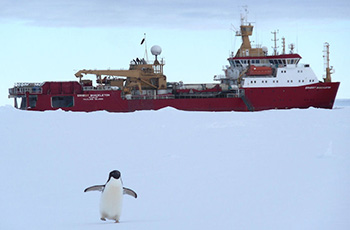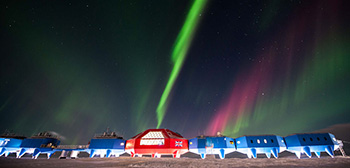AAE alumnus returns from 15 months with the British Antarctic Survey
 Purdue AAE alumnus Alexander Finch (MSAAE ’11) recently returned from 15 months in the Antarctic. He was part of a team of researchers who live and work at the Halley Research Station, which is run by the British Antarctic Survey (BAS). The state-of-the-art facility is made up of eight interlinked pods. The center pod contains areas for eating, exercising, and socializing, while the remaining pods contain sleeping quarters, laboratories, offices, generators, and other facilities.
Purdue AAE alumnus Alexander Finch (MSAAE ’11) recently returned from 15 months in the Antarctic. He was part of a team of researchers who live and work at the Halley Research Station, which is run by the British Antarctic Survey (BAS). The state-of-the-art facility is made up of eight interlinked pods. The center pod contains areas for eating, exercising, and socializing, while the remaining pods contain sleeping quarters, laboratories, offices, generators, and other facilities.
Finch and several dozen people arrived on Christmas Day in 2014, during the Antarctic “summer.” In March, when “winter” commenced, all but 12 of that group departed. The remaining team worked together to keep the station and the scientific experiments running.
While much of the research done at the facility focuses on the study of the Earth’s atmosphere-- measurements from Halley led to the discovery of the ozone hole in 1985- the remote location is also being used to study the potential impact on astronauts of a future mission to the Moon or Mars.
Finch says the isolation and darkness at Antarctic research stations during winter is similar to what astronauts might experience during a long-term space flight. He says the European Space Agency has several experiments going on at Halley Research Station intended to evaluate how this isolation effects human physiology and psychology.
 “It actually makes a lot of sense, because when you’re (in the Antarctic) you feel like you’re on another planet,” says Finch. “The fact that you’re isolated, cut off from the world, in a hostile environment, without a normal day and night cycle—this collectively is the best simulation we have on Earth replicating the environment on Mars or even on spacecraft on the way to Mars.”
“It actually makes a lot of sense, because when you’re (in the Antarctic) you feel like you’re on another planet,” says Finch. “The fact that you’re isolated, cut off from the world, in a hostile environment, without a normal day and night cycle—this collectively is the best simulation we have on Earth replicating the environment on Mars or even on spacecraft on the way to Mars.”
Finch says the research includes using a Soyuz simulator to test how an individual’s skills and reactions change during the months of darkness and isolation.
“By assessing how people behave in Antarctica, we can try and estimate how astronauts going to Mars will fare,” says Finch.
Finch says his time at Purdue gave him the start he needed to pursue a career he loves. He studied with Professor Daniel DeLaurentis and earned a Master’s degree in 2011.
 “My studies at Purdue gave me a full background into the world of spacecraft building and spaceflight. I have worked in the space industry ever since I graduated. The first job I got, I actually found the employer at a conference where I was presenting the thesis I did at Purdue.”
“My studies at Purdue gave me a full background into the world of spacecraft building and spaceflight. I have worked in the space industry ever since I graduated. The first job I got, I actually found the employer at a conference where I was presenting the thesis I did at Purdue.”
Finch encourages current AAE students to get involved in extracurricular activities related to their studies—he was a member of PurdueSAT during his time on the West Lafayette campus. He says doing a thesis or getting published is another good way to stand out to future employers.
Finch says his time with the British Antarctic Survey is just one of many space-related adventures he hopes to experience throughout his career.
“Like nearly everyone in the industry, I want to go to space one day,” says Finch. “I’m also interested in the Mars Analogue sites in Canada and the southwest United States, where they test the technologies and methodologies that would be used on a mission to Mars. But I’d really also like to get into the meat of designing things, really help build spacecraft.”
Finch says curiosity and love of what you’re doing are essential to be successful as a student at Purdue and after graduation.
photos provided by Alexander Finch
Top right photo: AAE alumni Alexander Finch in Antarctica during his time with the British Antarctic Survey
Center right photo: The RRS Shackleton, which is used to transport people and supplies to the Halley Research Station
Bottom right photo: The Halley Research Station in Antarctica
